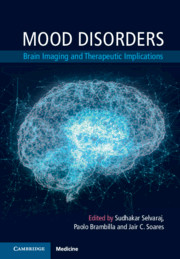Book contents
- Mood Disorders
- Mood Disorders
- Copyright page
- Contents
- Contributors
- Preface
- Section 1 General
- Section 2 Anatomical Studies
- Section 3 Functional and Neurochemical Brain Studies
- Section 4 Novel Approaches in Brain Imaging
- Chapter 11 Imaging Genetic and Epigenetic Markers in Mood Disorders
- Chapter 12 fMRI Neurofeedback as Treatment for Depression
- Chapter 13 Functional Near-Infrared Spectroscopy Studies in Mood Disorders
- Chapter 14 Electrophysiological Biomarkers for Mood Disorders
- Chapter 15 Magnetoencephalography Studies in Mood Disorders
- Chapter 16 An Overview of Machine Learning Applications in Mood Disorders
- Section 5 Therapeutic Applications of Neuroimaging in Mood Disorders
- Index
- Plate Section (PDF Only)
- References
Chapter 15 - Magnetoencephalography Studies in Mood Disorders
from Section 4 - Novel Approaches in Brain Imaging
Published online by Cambridge University Press: 12 January 2021
- Mood Disorders
- Mood Disorders
- Copyright page
- Contents
- Contributors
- Preface
- Section 1 General
- Section 2 Anatomical Studies
- Section 3 Functional and Neurochemical Brain Studies
- Section 4 Novel Approaches in Brain Imaging
- Chapter 11 Imaging Genetic and Epigenetic Markers in Mood Disorders
- Chapter 12 fMRI Neurofeedback as Treatment for Depression
- Chapter 13 Functional Near-Infrared Spectroscopy Studies in Mood Disorders
- Chapter 14 Electrophysiological Biomarkers for Mood Disorders
- Chapter 15 Magnetoencephalography Studies in Mood Disorders
- Chapter 16 An Overview of Machine Learning Applications in Mood Disorders
- Section 5 Therapeutic Applications of Neuroimaging in Mood Disorders
- Index
- Plate Section (PDF Only)
- References
Summary
Magnetoencephalography (MEG) has emerged as an important tool in the study of mood disorders. Although electroencephalography (EEG) is much more widely utilized, largely due to its low cost and ease of use, MEG has the distinct advantage of enabling accurate localization of brain structures. Although a full discussion of the methodology of MEG is beyond the scope of this brief chapter, we will present a brief overview of the technique and refer the reader to several excellent volumes (1–3) for more information.
- Type
- Chapter
- Information
- Mood DisordersBrain Imaging and Therapeutic Implications, pp. 192 - 205Publisher: Cambridge University PressPrint publication year: 2021

